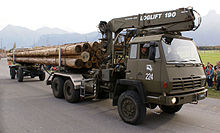Trailer (transport)



In the transport sector , trailer vehicles primarily used in long material transport , which are only connected to the towing vehicle by the load, are referred to as trailers . The combination of towing vehicle and trailer is called a bridge train . Trailers are used for the transport of particularly long goods, such as logs or prefabricated components .
History and technology
Until the 19th century, followers were mostly uniaxial. The original rigid trailers caused a move away from the inner edge of the curve by means of a drag curve with its own lane. The steering was done by an escort who followed the load, the Schwigger , Starzer or Wäpfer.
In order to be able to steer round timber better and more precisely in tight bends, the trailers were equipped from 1900 with a steering by means of a turntable , which was operated by the Schwigger sitting next to or under the load with a steering wheel. After the Second World War, two- and three-axle trailers were developed which can be steered from the driver's cab. In heavy transport -Nachläufern the steering is operated usually by a remote controller off the charge.
When loaded, the trailer is usually additionally secured to the towing vehicle with a central tube or wire rope.
The rear parts of articulated buses , which are provided with one or two axles and are connected to the front end of the vehicle with a joint, are also referred to as rear parts. Until the development of articulated pusher buses in the 1970s by the vehicle workshops in Falkenried (FFG), the trailer of the articulated buses had no drive or motor, they were pulled by the motor vehicle and mostly had an axle whose wheels were also steered.
A special trailer for towing vehicles is the dolly for semi-trailers.
See also
- Dolly
- Semi-trailers
- Tagalong (child bike trailer for adult bike)
Individual evidence
- ↑ Erich Hoepke, Stefan Breuer (Ed.): Commercial vehicle technology: Basics, systems, components . 8th edition. Springer-Verlag, 2016, ISBN 978-3-658-09537-6 , pp. 20 ( Google Books ).
- ^ Gerhard Klink, dimensioning of hairpin bends and junctions in forest road construction ; In: Allgemeine Forstzeitschrift , 1979, Volume 34, pp. 143 ff
